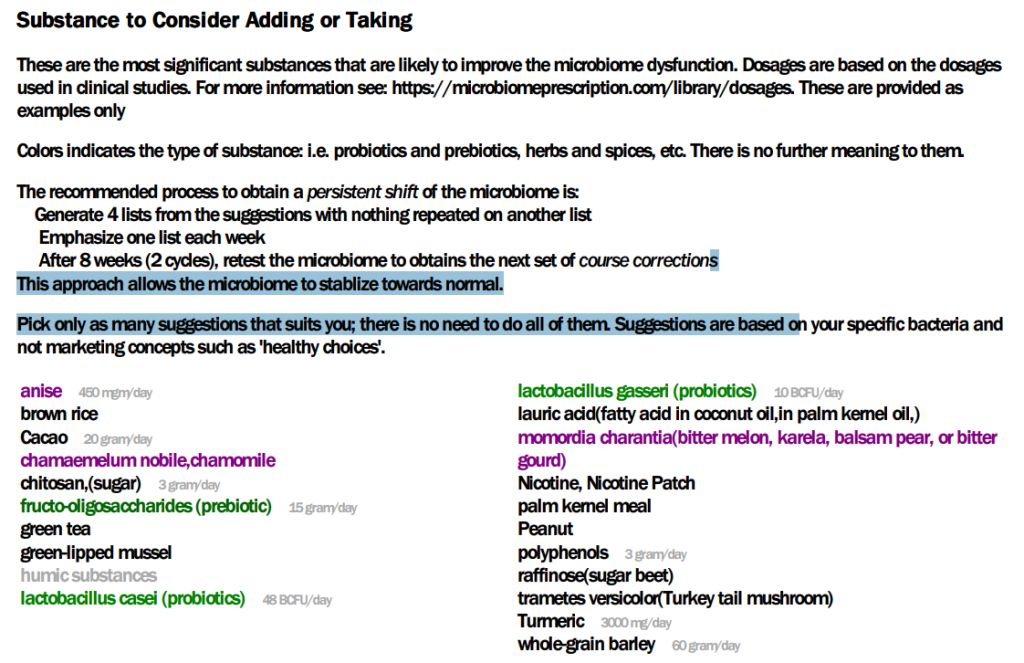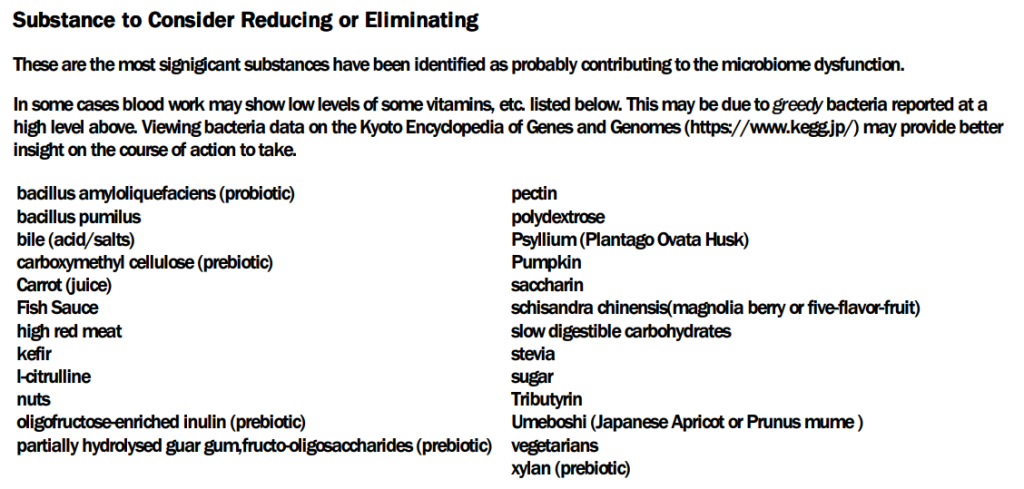Back Story:
Current Age: 25, male
Current Issues: chronic fatigue (not able to exercise or take walks longer than 10-15 min), strong brain fog & reduced cognitive abilities,
History:
Covid-19 infection in June 2022 followed by intense fatigue, followed by 1.5M of recovery, followed by spontaneous, severe crash (Post-exercise malaise, fatigue, strong brain fog) and continuing since then
I tried a ketogenic diet for 6 months (and a carnivore 4:1 ketogenic diet for 1 month) to treat these issues but this actually seemed to make my symptoms worse. Tried a broad spectrum of high dose supplements, vitamins and minerals that did not help at all. Currently slow re-introduction of carbs into my diet again.
Analysis
I can only review the current state since I am microbiome data-bound in reviews. It was interesting that two popular approaches advocated by influencers made him worse. There is no universal solutions / cure. Solutions are specific to the individual.
My usual starting point for ME/CFS and post-COVID is the Percentages of Percentiles chart. It is not a match for the usual pattern seen for those conditions, but we see statistically significant abnormalities in the 10-19%ile range. I have not seen this pattern before.

Looking at Potential Medical Conditions Detected, only Mood Disorders stands out. This is consistent with his past history. For Dr. Jason Hawrelak Recommendations, he’s at the 75%ile with the main items of concern being high Bacteroides, Bilophila wadsworthia, and low Bifidobacterium, Roseburia, Akkermansia.
Looking at Special Studies, the top item is likely due to a hybrid ME/CFS with post-COVID:

Where Do We Go From Here?
I am going to build a consensus report from the 4 “Just Give Me Suggestions” to which we will add:
- Special Studies: COVID19 (Long Hauler)
- Potential Medical Conditions Detected: Mood Disorders
There are two ways of looking at suggestions (similar results but minor differences). Using the PDF Download or looking at the details.

In this case (these do not always appear), probiotics too.

Before moving onto the detail view, let us look at KEGG computed probiotics:
- #1 was Escherichia coli (which is symbioflor 2 above or Mutaflor). The items below are at 1/6th the estimated contribution.
- Latilactobacillus sakei subsp. sakei is also a positive in the list
- Lactococcus lactis and the other ones in Filmjolk (a Swedish drink) are positive. There are some retail variation availables else where, for example Siggi’s Filmjolk Drinkable Yogurt (other bacteria added) and some starters such as NW Ferments Filmjolk Yogurt Starter.
- Lacticaseibacillus casei, Lactobacillus gasseri are also positive
NOTE: Escherichia coli is a troublesome bacteria because it is poorly/not measured with the typical 16s technology.
In terms of detail view, the following are at the top:
- Cacao (540) see this 2012 post and 2017
- lactobacillus casei (probiotics)
- raffinose(sugar beet)
- lactobacillus gasseri (probiotics)
None of the antibiotics or prescription items are above 330; I am disinclined to consider them. During my own recovery, I found that I had a craving for peanut butter (some posts on peanuts: 2013, 2015). There is some evidence that it may improve the ability of the blood to delivery oxygen to the brain in some cases (which may help with cognitive issues). Peanuts do contain Resveratrol [2000] and the question arose below whether just resveratrol alone could be substituted?
Reviewing what he tried…
Ketogenic diet for 6 months… this actually seemed to make my symptoms worse.

I would expect that to make things worse — as shown above.
Tried a broad spectrum of high dose supplements, vitamins and minerals that did not help at all.
Remember that 50% of the highest value (540) is my usual demarcation line for suggestions (270). Interesting that not a single vitamin or mineral was even close! About half of them were negatives!

The response from what he tried pre microbiome-sample agrees with the predicted response.
What he should reduce or avoid
This leads us to the next item, items to avoid. They will definitely not sweeten up his life: minimum usage of sugar, saccharin, stevia – but raffinose is fine. Note that nuts are on this list — wait! How can this be? Peanuts is on the to take list. The answer is simple: misnaming. Peanuts are NOT nuts (they look like nuts) but a legume!

Questions and Answers
Q: the probiotics dosages stated on the page I was wondering: The page lists the CFUs as X*BCFUs (with the B meaning Billion I suppose?) tho the studies linked to the dosages used mostly dosages in the range of X*10^9 CFUs. Am I missing something? (Because e.g. for lactobacillus casei 48 x10^9 CFUs would seem a lot)
- A: I do not know the number needed to insure effective change. The dosages are based on dosages used in Clinical studies and thus dosages that are inferred safe (and someone decided was needed — often the results of earlier studies where only a few responded). See 📏🍽️ Dosages for Supplements for links to the studies. There is a difference between maintenance dosages (keep the status quo) and therapeutic dosage (upset the microbiome’s apple cart).
Context for Next Questions
Cookbook Suggestions were created from a list of specific substances provided by a reader supporting Long COVID with some specific directions on how she wanted items evaluated. It is not the preferred list. The preferred methods are looking at the “Technical details” (in horrible complexities — with 1,774 entries for this sample) or using the PDF that filters to keep the number of items low but working off the same numbers.

Q: Cookbook suggestions: Cookbook gave me a clear thumbs down for Bifidobacterium bifidum, and Lactobacillae Rhamnosus and plantarum, tho when I went into detail view or to the consensus suggestions they were ranked well along the other takes. Would you say therefore take or avoid is more recommendable (as I have two probiotics already at home that have these strains in them)


- A: As shown above, two are negative (thus avoid), the other one is low positive. (The values range from 539 down to -460). It is unlikely to have any significant impact.

Q: Peanut/ Resveratrol: In addition to eating peanuts, could I also use resveratrol extract to boost the process?
- A: This raises the issue of humans wanting to simplify things, sometimes too far. Peanuts contains other things besides resveratrol. This could be it main mechanism of action — but other components may also be acting in isolation or combination. I checked the numbers, and would surmise that the other factors are significant contributors important here. Remember, we are working from very sparse data (despite having 1.9 million facts, we have 20,000 bacteria over 2000 modifiers. i.e. 1.9 million to 40 million combinations is only 5% (or less) hit rate).
So, it may help — but not sufficiently to exclude peanuts (or that horrible American food: peanut butter!)

Postscript – and Reminder
I am not a licensed medical professional and there are strict laws where I live about “appearing to practice medicine”. I am safe when it is “academic models” and I keep to the language of science, especially statistics. I am not safe when the explanations have possible overtones of advising a patient instead of presenting data to be evaluated by a medical professional before implementing.
I can compute items to take, those computations do not provide solid information on rotations, dosages, etc.
I cannot tell people what they should take or not take. I can inform people items that have better odds of improving their microbiome as a results on numeric calculations. I am a trained experienced statistician with appropriate degrees and professional memberships. All suggestions should be reviewed by your medical professional before starting. Some suggestions may be counterindicated for other medications you are taking and medical conditions.
The answers above describe my logic and thinking and is not intended to give advice to this person or any one. Always review with your knowledgeable medical professional.
Recent Comments